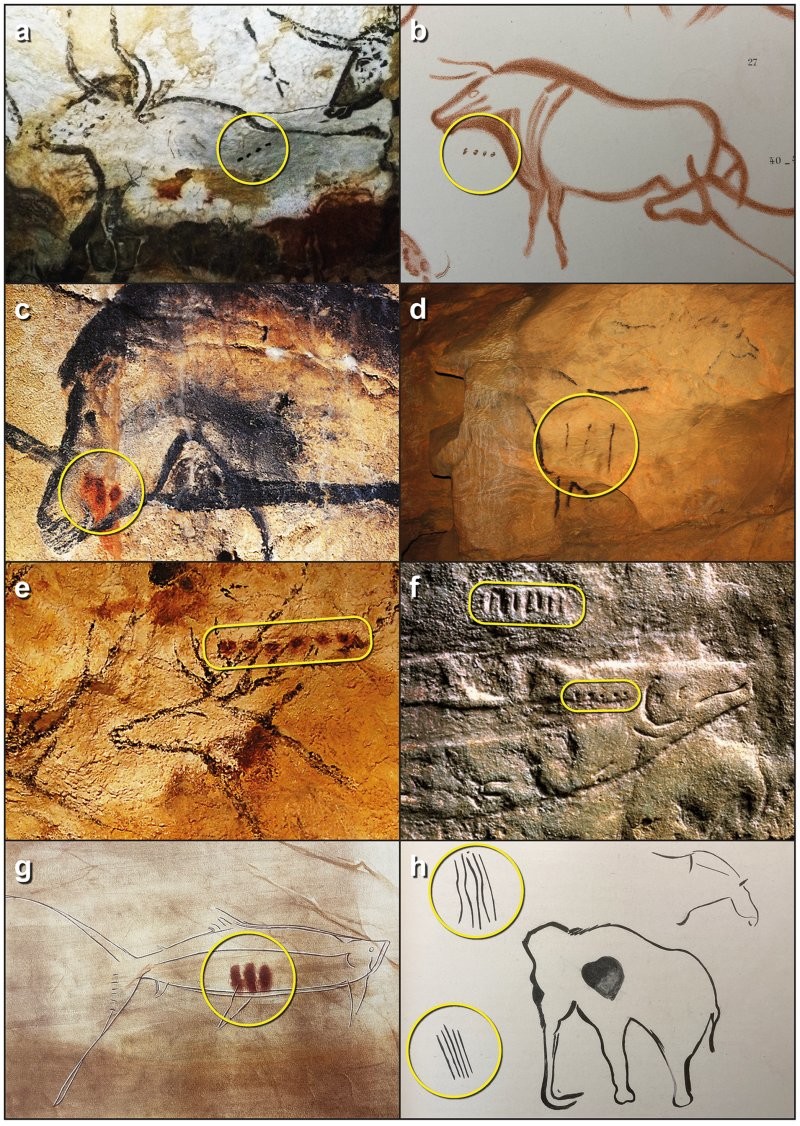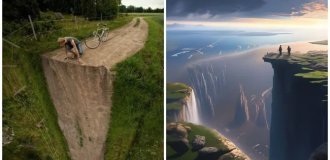20,000-year-old painted dots may be the earliest written language, study claims (6 photos)
Dots, lines and Y-shaped signs of the Stone Age can represent a type of proto-writing created by hunter-gatherers, who lived in Europe at least 20,000 years ago. 
At least 20 thousand years ago, people living in Europe, created amazing cave paintings of animals that they combined with curious signs: lines, dots and Y-shaped symbols. These signs, which are well known to researchers, may be associated with the seasonal behavior of predatory animals, which makes signs the first famous writings in the history of mankind, asserts a new study.
Although Paleolithic cave art is better known for its graceful horses and ghostly handprints, there are thousands non-figurative or abstract characters that specialists have started studied only in the last few decades. In the study, published January 5 in the Cambridge Archeology Journal, a group of scientists suggests that these seemingly abstract points and lines located next to the images of animals, in fact, represent a complex system of writing that explains the understanding of the ancients mating seasons and births of important native species.
Rock painting from 21,500 years ago depicting bison, an extinct species of cattle, in the caves of Lasko wo France. Pay attention to four points that could have a special significance for peoples of the ice age 
However, other researchers are not convinced by the study's interpretation of these human-made markings.
Melanie Chang, a paleoanthropologist based in Portland state university, not participating in the study, reported Live Science in an email that she agrees with the assessment researchers that "the people of the Upper Paleolithic had cognitive ability to write and keep track of time. However, she warned that “the hypotheses of the researchers are not well supported by their results, and they also do not affect alternative interpretations signs they analyzed.
In this image of an engraved salmon aged 17 thousand years from the Pindal cave in Asturias, Spain, inside there are three lines 
What do the drawn signs mean?
Early humans in Europe were hunter-gatherers who ate a lot of meat from horses, deer and bison. When these animals are seasonal gathered in herds, they became good targets for people.
“From this it follows that knowledge of the timing of migrations, mating and having children was central to behavior in the upper Paleolithic,
- the first author wrote in his study research Bennett Bacon, independent researcher and furniture restorer from London, and his colleagues.
After examining the total number of marks - points or lines - found in sequences in hundreds of caves, the researchers found that neither one of the series does not contain more than 13 marks, which corresponds to 13 lunar months in each year.
“We assume that sequences convey information about associated taxa of animals in units of months, they wrote, noting that spring, with its obvious signals of the end of winter and appropriate faunal migrations to breeding grounds would provide obvious, albeit regionally distinct, point of origin of the lunar calendar."
Annotated depiction of a painting approximately 23 years old thousand years, which shows four points associated with the picture red ocher bison in La Pasiega cave in Cantabria, Spain 
Statistical analysis by researchers of over 800 sequences signs associated with animals confirms their idea - they discovered strong correlation between the number of signs and lunar months, in which a particular animal is known to mate with.
Taking their hypothesis one step further, Bacon and his colleagues focused on the Y-shaped sign, which they believe refers to certain event in the life cycle of an animal. Like statistical analysis supports their conclusion that placement A Y-shaped mark in a series of marks signals the season of birth animals.
"The ability to assign abstract signs to phenomena in the world, - they say, to record past events and predict future event, was a profound intellectual achievement."
Writing or prototyping?
But is this the earliest known writing? bacon and his colleagues object, suggesting thatabout “she is best described as proto-writing, an intermediate step between simpler designations/agreements and full-fledged writing.
April Nowell, Paleolithic archaeologist from University of Victoria in Canada, which did not participate in this study, reported that "any study in which more than non-figurative signs are examined in detail, welcome, but I think that a number of assumptions are made here, which have yet to be proved. AT In particular, Nowell questioned the Y sign.
Most of the animals considered in this study are quadrupeds, and people usually give birth on their haunches,” she said. - If this sign should symbolize the process of birth, then for me it is not obvious."
Chang, a paleoanthropologist who is also an equestrian and horse owner, offered two alternative explanations for the Y sign. in some cases, this may be the edge of the brachiocephalic muscle, noticeable landmark on the horse's neck.
“In other cases,” she said, “it is possible that what they written as Y, represents what modern people doing horses are called "primitive markings" such as stripes on legs that are associated with the color of wild-type horses, or they may represent hair patterns or other anatomical peculiarities."
Study co-author Robert Kentridge, Professor Department of Psychology at Durham University in the UK Live Science in email, which is one of their strengths research is that they "formally tested hypotheses Ben (Bacon) on the meaning of the position of the Y sign in the sequence of signs and lengths of sequences of points and lines and showed that they are actually actually convey meaning, the meaning that would be important in life Paleolithic hunters.
Summarizing their findings, Bacon and his colleagues wrote that they “suggested the existence of a system of notation associated with unambiguous animal associated with biologically significant events, and that it allows them "for the first time to understand the notation of the era Paleolithic in its entirety.
Non-figurative signs dating back 15 thousand years ago, which hunter-gatherers painted in black manganese and red ocher in Cave of Nyo in the French Pyrenees 
However, ten years ago, Nowell and then-graduate student Genevieve Von Petzinger (Genevieve von Petzinger) jointly created a database dozens of signs and recurring motifs from more than 200 caves in the south France and Spain. Von Petzinger's dissertation details the schemes symbols of cave walls in time and space in order to better understand what these signs meant for people of the ice age.
“There are at least 32 different repeating characters,” explained Nowell. — The authors decided to study three of them in a very specific way. context."
As a result, the authors defended their decision to focus on the trio.
“It seemed wise to first focus on the most common signs associated with figurative images - study co-author Paul told Live Science in an email Pettit (Paul Pettitt), professor of archeology at the University of Durham. — Simple dots and lines are the most common. From more complex signs the most common is the Y sign.
The researchers plan to expand their work.
“We are analyzing other signs,” Bacon said. - Instead of In order to look for the meaning of individual signs, we are looking for linguistic and the cognitive foundations that underlie the "writing" system."
Nowell agreed with the authors of the study that the symbols most likely were not chosen by chance and that, quite possibly, the lines and dots represent numbers. She noted that even if the authors right, 90% of the signs are left with no known meaning.
“There is still a lot about graphic communication in the Paleolithic era that we don’t understand,” Nowell said. 





















